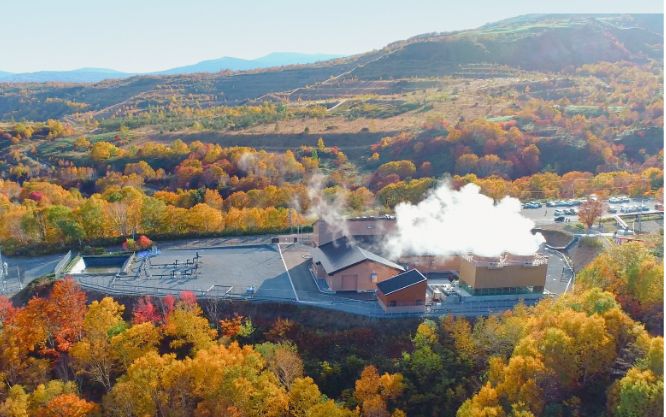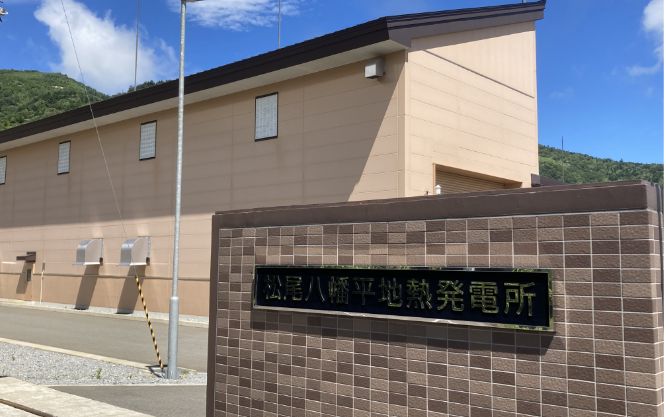Energy
Creating the future of next-generation energy as a pioneer in geothermal power generation
We built our own power plant because manufacturing ferroalloys requires a large amount of electricity. Moreover, we chose geothermal power generation as our power generation method because we have been highly conscious of protecting the natural environment since our early days. In 1966, before the word “ecology” was widely used, we established Japan’s first geothermal power plant in Matsukawa, Iwate Prefecture. Since then, the Energy Business has been important to us. We will continue to focus on developing the future of next-generation energy with the technology and experience we have nurtured.
Matsukawa Geothermal Power Plant
 (Photo taken around 2000)
(Photo taken around 2000)-
1966: First geothermal power plant in Japan
Japan’s first geothermal power plant constructed in 1966. On October 8, 1966, Japan’s first commercial-scale geothermal power plant began operation. It was the only steam-dominant type in Japan with a power generation capacity of 23.5 MW. The first well of the Matsukawa Geothermal Power Plant in Iwate Prefecture was the first production well in Japan, which successfully fumed in 1964. It has been confirmed that this steam was able to generate 6,000 kW of electricity, giving momentum to geothermal development in Japan.

-
Reason why we chose geothermal power generation
Geothermal power generation emits almost no CO2 in the process of power generation and does not depend on fossil resources such as oil or coal. Unlike solar power generation and wind power generation, geothermal power generation is not affected by weather or time of day and can generate stable power. Furthermore, geothermal power can be generated from geothermal resources in various parts of Japan without having to import resources for electricity generation, providing the peace of mind that only domestically produced energy can provide.
Matsuo-Hachimantai Geothermal Power Plant

-
Design that does not degrade the landscape
The Matsuo-Hachimantai Geothermal Power Plant, which began generating power in January 2019, is capable of producing 7,000 kW of power (installation capacity: 7,499 kW), which is equivalent to the amount of electricity consumed by 15,000 ordinary households. No new geothermal power plant has been built in Japan for a long time, and this is the first geothermal power plant built in Japan in 22 years. In addition, the plant was awarded the New Energy Award in 2019 for many innovations that took into consideration the surrounding natural environment and landscape.

-
Matsuo-Hachimantai Geothermal Center
We have been engaged in the operation, maintenance, and security management of the Matsuo-Hachimantai Geothermal Power Plant since the start of trial operation, when we were commissioned by Iwate Geothermal Power Co., Ltd. At the beginning of the operation, we were on site 24 hours a day, but after one and a half years of operation, remote monitoring operations began at Iwate Geothermal’s head office at the foot of the power plant. A year later, remote monitoring operations were transferred to our Minami Iwate Office (Kitakami City, Iwate Prefecture). Therefore, the center now performs daytime maintenance and inspection work on site.
We will continue our efforts to ensure stable operation of the Matsuo-Hachimantai Geothermal Power Plant through various inspections, maintenance, and security management of wells and power generation facilities, seasonal maintenance and management of equipment, and early restoration in the event of sudden accidents.
Date Solar Power Plant

-
Annual power generation: 1.92 million kWh
Solar (photovoltaic) power generation is another one of our approaches to creating renewable energy. The Date Solar Power Plant started operation in October 2013. The number of solar cell modules installed at the plant is 7,636. The 1.92 million kWh generated annually would power 500 to 550 ordinary households.
Mori Geothermal Center

-
Multifaceted support for geothermal power generation for electric power companies
The Mori Geothermal Power Plant, the first geothermal power station in Hokkaido, started operation in November 1982 and has been producing geothermal power for approximately 40 years. Nigorikawa, where the Mori Geothermal Power Plant is located, has abundant underground resources, and produces steam necessary for geothermal power generation. Of the steam and hot water that erupt, a portion of the hot water not used for power generation is provided to the community by Hokkaido Electric Power Co., Inc., and the hot water heated by a heat exchanger is supplied to horticultural facilities. The center received the Northern Districts’ Energy Conservation and New Energy Award in 2019. The Mori Geothermal Center has been involved in the operation of the steam production facility since its inception and is currently commissioned by Hokkaido Electric Power Co., Inc. to manage its operation and maintenance, as well as to plan and budget for repairs necessary to maintain the facility. In addition, the Japan Metals & Chemicals Group’s geothermal companies, led by the Mori Geothermal Center, work together to repair facilities, and provide multifaceted support for the maintenance of the steam production facility at the Mori Geothermal Power Plant.
Kakkonda Geothermal Power Plant
 Photo provided by Tohoku Sustainable & Renewable Energy Co. Inc.
Photo provided by Tohoku Sustainable & Renewable Energy Co. Inc.-
The Kakkonda Geothermal Power Plant is located in Towada-Hachimantai National Park, above the Torigoe Falls along the upper reaches of the Kakkonda River in Shizukuishi-town, Iwate Prefecture. In 1969, we (JMC) started a exploration program for geothermal development. And in May 1978, the Kakkonda Geothermal Unit 1, which had a power generation output of 50,000 kW, was put into operation.
Tohoku Geothermal Energy Co., Ltd., which took over the geothermal development from us (JMC), succeeded in its first exploration well in 1984. And in March 1996, the Kakkonda Geothermal Unit 2 started power generation of 30,000 kW.
We were (JMC was) in charge of the steam supply division of Unit 1, Tohoku Geothermal Energy Co., Ltd. was in charge of the steam supply division of Unit 2, and Tohoku Electric Power Inc. was in charge of the power generation division. But now Tohoku Electric Power Inc. is in charge of all divisions. And in light of the attenuation of steam volume and the aging of facility, Kakkonda Unit 1 was decommissioned in October 2022.
And in 1995, it is noted that the world’s highest temperature of 512°C was recorded in the well with a depth of 3,729m at Kakkonda area, by New Energy and Industrial Technology Development Organization (NEDO).

